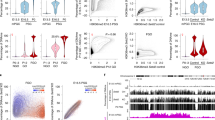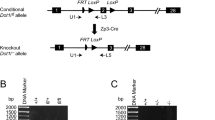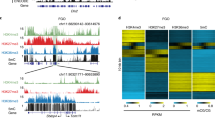Abstract
Differential DNA methylation of the paternal and maternal alleles regulates the parental origin-specific expression of imprinted genes in mammals1,2. The methylation imprints are established in male and female germ cells during gametogenesis, and the de novo DNA methyltransferase DNMT3A and its cofactor DNMT3L are required in this process3,4,5. However, the mechanisms underlying locus- and parental-specific targeting of the de novo DNA methylation machinery in germline imprinting are poorly understood. Here we show that amine oxidase (flavin-containing) domain 1 (AOF1), a protein related to the lysine demethylase KDM1 (also known as LSD1)6, functions as a histone H3 lysine 4 (H3K4) demethylase and is required for de novo DNA methylation of some imprinted genes in oocytes. AOF1, now renamed lysine demethylase 1B (KDM1B) following a new nomenclature7, is highly expressed in growing oocytes where genomic imprints are established. Targeted disruption of the gene encoding KDM1B had no effect on mouse development and oogenesis. However, oocytes from KDM1B-deficient females showed a substantial increase in H3K4 methylation and failed to set up the DNA methylation marks at four out of seven imprinted genes examined. Embryos derived from these oocytes showed biallelic expression or biallelic suppression of the affected genes and died before mid-gestation. Our results suggest that demethylation of H3K4 is critical for establishing the DNA methylation imprints during oogenesis.
This is a preview of subscription content, access via your institution
Access options
Subscribe to this journal
Receive 51 print issues and online access
$199.00 per year
only $3.90 per issue
Buy this article
- Purchase on Springer Link
- Instant access to full article PDF
Prices may be subject to local taxes which are calculated during checkout




Similar content being viewed by others
References
Reik, W. & Walter, J. Genomic imprinting: parental influence on the genome. Nature Rev. Genet. 2, 21–32 (2001)
Edwards, C. A. & Ferguson-Smith, A. C. Mechanisms regulating imprinted genes in clusters. Curr. Opin. Cell Biol. 19, 281–289 (2007)
Kaneda, M. et al. Essential role for de novo DNA methyltransferases Dnmt3a in paternal and maternal imprinting. Nature 429, 900–903 (2004)
Bourc’his, D., Xu, G. L., Lin, C. S., Bollman, B. & Bestor, T. H. Dnmt3L and the establishment of maternal genomic imprints. Science 294, 2536–2539 (2001)
Hata, K., Okano, M., Lei, H. & Li, E. Dnmt3L cooperates with the Dnmt3 family of de novo DNA methyltransferases to establish maternal imprints in mice. Development 129, 1983–1993 (2002)
Shi, Y. et al. Histone demethylation mediated by the nuclear amine oxidase homolog LSD1. Cell 119, 941–953 (2004)
Allis, C. D. et al. New nomenclature for chromatin-modifying enzymes. Cell 131, 633–636 (2007)
Stavropoulos, P., Blobel, G. & Hoelz, A. Crystal structure and mechanism of human lysine-specific demethylase-1. Nature Struct. Mol. Biol. 13, 626–632 (2006)
Chen, Y. et al. Crystal structure of human histone lysine-specific demethylase 1 (LSD1). Proc. Natl Acad. Sci. USA 103, 13956–13961 (2006)
Li, E., Beard, C. & Jaenisch, R. Role for DNA methylation in genomic imprinting. Nature 366, 362–365 (1993)
Howell, C. Y. et al. Genomic imprinting disrupted by a maternal effect mutation in the Dnmt1 gene. Cell 104, 829–838 (2001)
Nakamura, T. et al. PGC7/Stella protects against DNA demethylation in early embryogenesis. Nature Cell Biol. 9, 64–71 (2007)
Hirasawa, R. et al. Maternal and zygotic Dnmt1 are necessary and sufficient for the maintenance of DNA methylation imprints during preimplantation development. Genes Dev. 22, 1607–1616 (2008)
Li, X. et al. A maternal-zygotic effect gene, Zfp57, maintains both maternal and paternal imprints. Dev. Cell 15, 547–557 (2008)
Tamaru, H. & Selker, E. U. A histone H3 methyltransferase controls DNA methylation in Neurospora crassa . Nature 414, 277–283 (2001)
Jackson, J. P., Lindroth, A. M., Cao, X. & Jacobsen, S. E. Control of CpNpG DNA methylation by the KRYPTONITE histone H3 methyltransferase. Nature 416, 556–560 (2002)
Lehnertz, B. et al. Suv39h-mediated histone H3 lysine 9 methylation directs DNA methylation to major satellite repeats at pericentric heterochromatin. Curr. Biol. 13, 1192–1200 (2003)
Vire, E. et al. The Polycomb group protein EZH2 directly controls DNA methylation. Nature 439, 871–874 (2006)
Wang, J. et al. The lysine demethylase LSD1 (KDM1) is required for maintenance of global DNA methylation. Nature Genet. 41, 125–129 (2009)
Ooi, S. K. et al. DNMT3L connects unmethylated lysine 4 of histone H3 to de novo methylation of DNA. Nature 448, 714–717 (2007)
Jia, D., Jurkowska, R. Z., Zhang, X., Jeltsch, A. & Cheng, X. Structure of Dnmt3a bound to Dnmt3L suggests a model for de novo DNA methylation. Nature 449, 248–251 (2007)
Obata, Y. & Kono, T. Maternal primary imprinting is established at a specific time for each gene throughout oocyte growth. J. Biol. Chem. 277, 5285–5289 (2002)
Chen, T., Ueda, Y., Dodge, J. E., Wang, Z. & Li, E. Establishment and maintenance of genomic methylation patterns in mouse embryonic stem cells by Dnmt3a and Dnmt3b. Mol. Cell. Biol. 23, 5594–5605 (2003)
Acknowledgements
We thank Y. Shi, J. Wang, G. A. Baltus, T. B. Nicholson, S. Kadam and H. M. Chan for discussions, and J. Wang, J. Kurash and G. A. Baltus for technical assistance.
Author Contributions T.C. planned and supervised the project. D.N.C. and T.C. designed the experiments and wrote the manuscript. D.N.C., E.L. and T.C. analysed the data. D.N.C., H.S., S.H., F.G., H.L., J.B. and T.C. carried out the experiments. G.X. generated the DNMT3A and DNMT3L antibodies.
Author information
Authors and Affiliations
Corresponding author
Ethics declarations
Competing interests
All authors except G.X. are employees of Novartis Institutes for Biomedical Research.
Supplementary information
Supplementary Information
This file contains Supplementary Figures 1-8 with Legends and Supplementary Tables 1-2. (PDF 866 kb)
Rights and permissions
About this article
Cite this article
Ciccone, D., Su, H., Hevi, S. et al. KDM1B is a histone H3K4 demethylase required to establish maternal genomic imprints. Nature 461, 415–418 (2009). https://doi.org/10.1038/nature08315
Received:
Accepted:
Published:
Issue Date:
DOI: https://doi.org/10.1038/nature08315
This article is cited by
-
Expression analysis suggests that DNMT3L is required for oocyte de novo DNA methylation only in Muridae and Cricetidae rodents
Epigenetics & Chromatin (2023)
-
Epigenetic effects of herbal medicine
Clinical Epigenetics (2023)
-
Specific regulation of BACH1 by the hotspot mutant p53R175H reveals a distinct gain-of-function mechanism
Nature Cancer (2023)
-
Loss of the Maternal Effect Gene Nlrp2 Alters the Transcriptome of Ovulated Mouse Oocytes and Impacts Expression of Histone Demethylase KDM1B
Reproductive Sciences (2023)
-
RETRACTED ARTICLE: Targeting KDM1B-dependent miR-215-AR-AGR2-axis promotes sensitivity to enzalutamide-resistant prostate cancer
Cancer Gene Therapy (2022)
Comments
By submitting a comment you agree to abide by our Terms and Community Guidelines. If you find something abusive or that does not comply with our terms or guidelines please flag it as inappropriate.



